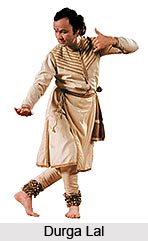 Durga Lal who was known as Pandit Durga Lal was a renowned Kathak Dancer of India. He was a dancer from Jaipur Gharana.
Durga Lal who was known as Pandit Durga Lal was a renowned Kathak Dancer of India. He was a dancer from Jaipur Gharana.
Early Life of Durga Lal
Pandit Durga Lal was born in the year 1948. Durga Lal was a renowned Kathak dancer of the Jaipur Gharana. He was born in Mahendragarh of Rajasthan.
Career of Durga Lal
Pandit Durga Lal is known for playing the title main role in the 1989 dance drama Ghanashyam; the music of which was composed by Pt. Ravi Shankar and was produced by Birmingham Opera Company. Durga Lal was a disciple of Sunder Prasadji. Along with being a Kathak dancer, Durga Lal was also a singer and would play Pakhvaj. He taught Kathak at the National Institute of Kathak Dance (Kathak Kendra), New Delhi. The brother of Durga Lal, Pandit Devi Lal was also a renowned Kathak dancer. Devi Lal`s wife Gitanjali Lal is also a Sangeet Natak Akademi Award winner (2007). Both brothers died at an early age. After Durga Lal`s death his children and other art fraternity members have been organising an annual festival called Pandit Durga Lal Memorial Festival.
Award Received by Durga Lal
Pandit Durga Lal was awarded Padma Shri Award by Government of India for his contribution in Indian Kathak Dance. Pandit Durga Lal had also received the Sangeet Natak Akademi Award for the year 1984.
Personal Life of Durga Lal
Pandit Durga Lal has two children, elder daughter Nupur and younger son Mohit. Nupur is Kathak performer and vocalist and Mohit is a percussionist. His disciples include renowned dancers Uma Dogra and Jayant Kastuar amongst others. In memory of Lal, Dogra has arranged the "Pandit Durga Lal Samaroh" for more than 15 years as of 2005. She has also made a documentary "Nirvana Through Dance" on him
Pandit Durga Lal died on 21st January in the year 1990.
This article is a stub. You can enrich by adding more information to it. Send your Write Up to [email protected]



















